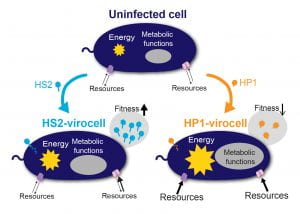JGI highlights Dr. Howard-Varona’s work on virocells

How a cell behaves as virocell largely depends on the infecting virus and the genomic similarity between host and virus. Pseudoalteromonas was infected with two unrelated viruses: siphovirus PSA-HS2 and podovirus PSA-HP1. The infections transformed the same bacterial host into two very different virocells, HS2-virocell and HP1-virocell. The HS2 siphovirus genome was much more similar to the host than the genome of HP1 podovirus and had better access to recycle existing host resources. In contrast, the HP1 podovirus needed to work harder at obtaining the resources needed for infection, and reprogrammed multiple host metabolisms. HS2 virocells had a comparatively higher fitness than HP1 virocells. (Figure by Cristina Howard-Varona)
If it looks like a duck and quacks like a duck, so the adage goes, it must be a duck. But if the duck gets infected by a virus so that it no longer looks or quacks like one, is it still a duck? For a team led by researchers from The Ohio State University and the University of Michigan studying how virus infections cause significant metabolic changes in marine microbes, the answer is no. They refer to the infected microbial cells as virocells, a change in name first described in 2011 which reflects the metabolic changes they’ve undergone.
Read full article here.

Comments are closed, but trackbacks and pingbacks are open.